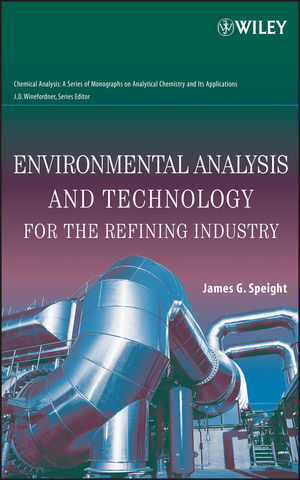Environmental Analysis and Technology for the Refining IndustryISBN: 978-0-471-67942-4
Hardcover
368 pages
August 2005
 This is a Print-on-Demand title. It will be printed specifically to fill your order. Please allow an additional 10-15 days delivery time. The book is not returnable.
|
||||||
Preface xi
Part I Petroleum Technology 1
Chapter 1 Definitions and Terminology 3
1.1 The Environment 4
1.2 Petroleum 9
1.3 Classification 11
1.3.1 Chemical Composition 12
1.3.2 Correlation Index 13
1.3.3 Density 14
1.3.4 Carbon Distribution 15
1.3.5 Viscosity–Gravity Constant 15
1.3.6 UOP Characterization Factor 16
1.4 Petroleum Products 16
1.4.1 Boiling Range 19
1.4.2 Environmental Behavior 19
1.5 Refinery Waste 20
1.5.1 Chemical Characteristics 21
1.5.2 Environmental Behavior 25
References 27
Chapter 2 Composition and Properties 31
2.1 Composition 32
2.1.1 Elemental Composition 32
2.1.2 Chemical Composition 33
2.1.3 Composition by Volatility 35
2.1.4 Composition by Fractionation 37
2.2 Properties 40
2.2.1 Density and Specific Gravity 40
2.2.2 Elemental (Ultimate) Analysis 41
2.2.3 Fractionation by Chromatography 42
2.2.4 Liquefaction and Solidification 44
2.2.5 Metals Content 44
2.2.6 Spectroscopic Properties 45
2.2.7 Surface and Interfacial Tension 47
2.2.8 Viscosity 49
2.2.9 Volatility 51
References 53
Chapter 3 Refinery Products and By-Products 57
3.1 Refinery Products 60
3.1.1 Liquefied Petroleum Gas 64
3.1.2 Naphtha, Gasoline, and Solvents 68
3.1.3 Kerosene and Diesel Fuel 71
3.1.4 Fuel Oil 71
3.1.5 Lubricating Oil 74
3.1.6 White Oil, Insulating Oil, and Insecticides 75
3.1.7 Grease 75
3.1.8 Wax 76
3.1.9 Asphalt 77
3.1.10 Coke 77
3.2 Petrochemicals 78
3.3 Refinery Chemicals 80
3.3.1 Alkalis 80
3.3.2 Acids 81
3.3.3 Catalysts 83
References 86
Chapter 4 Refinery Wastes 87
4.1 Process Wastes 90
4.1.1 Desalting 92
4.1.2 Distillation 93
4.1.3 Visbreaking and Coking 96
4.1.4 Fluid Catalytic Cracking 98
4.1.5 Hydrocracking and Hydrotreating 99
4.1.6 Alkylation and Polymerization 101
4.1.7 Catalytic Reforming 105
4.1.8 Isomerization 105
4.1.9 Deasphalting and Dewaxing 106
4.2 Entry into the Environment 108
4.2.1 Storage and Handling of Petroleum Products 108
4.2.2 Release into the Environment 110
4.3 Toxicity 113
4.3.1 Lower-Boiling Constituents 114
4.3.2 Higher-Boiling Constituents 117
4.3.3 Total Petroleum Hydrocarbons 119
4.3.4 Wastewater 120
References 121
Part II Environmental Technology and Analysis 123
Chapter 5 Environmental Regulations 125
5.1 Environmental Impact of Refining 131
5.1.1 Air Pollution 131
5.1.2 Water Pollution 132
5.1.3 Soil Pollution 132
5.2 Environmental Regulations in the United States 132
5.2.1 Clean Air Act 133
5.2.2 Resource Conservation and Recovery Act 137
5.2.3 Clean Water Act 140
5.2.4 Safe Drinking Water Act 141
5.2.5 Comprehensive Environmental Response, Compensation, and Liability Act 142
5.2.6 Oil Pollution Act 143
5.2.7 Occupational Safety and Health Act 144
5.2.8 Toxic Substances Control Act 144
5.2.9 Hazardous Materials Transportation Act 146
5.3 Refinery Outlook 146
5.3.1 Hazardous Waste Regulations 146
5.3.2 Regulatory Background 147
5.3.3 Requirements 147
5.4 Management of Refinery Waste 148
References 149
Chapter 6 Sample Collection and Preparation 151
6.1 Petroleum Chemicals 151
6.2 Sample Collection and Preparation 153
6.2.1 Sample Collection 154
6.2.2 Extract Concentration 168
6.2.3 Sample Cleanup 170
6.3 Measurement 170
6.4 Accuracy 172
6.5 Precision 173
6.6 Method Validation 174
6.7 Quality Control and Quality Assurance 179
6.7.1 Quality Control 179
6.7.2 Quality Assurance 181
6.8 Method Detection Limit 182
References 183
Chapter 7 Analytical Methods 185
7.1 Leachability and Toxicity 186
7.2 Total Petroleum Hydrocarbons 186
7.2.1 Gas Chromatographic Methods 191
7.2.2 Infrared Spectroscopy Methods 195
7.2.3 Gravimetric Methods 196
7.2.4 Immunoassay Methods 198
7.3 Petroleum Group Analysis 198
7.3.1 Thin-Layer Chromatography 200
7.3.2 Immunoassay 201
7.3.3 Gas Chromatography 201
7.3.4 High-Performance Liquid Chromatography 203
7.3.5 Gas Chromatography–Mass Spectrometry 204
7.4 Petroleum Fractions 205
References 206
Chapter 8 Total Petroleum Hydrocarbons 207
8.1 Petroleum Constituents 209
8.2 Analytical Methods 210
8.2.1 Environmental Samples 210
8.2.2 Biological Samples 217
8.2.3 Semivolatile and Nonvolatile Hydrocarbons 228
8.3 Assessment of the Methods 230
References 234
Chapter 9 Analysis of Gaseous Effluents 237
9.1 Gaseous Products 239
9.1.1 Liquefied Petroleum Gas 239
9.1.2 Natural Gas 240
9.1.3 Refinery Gas 241
9.1.4 Sulfur Oxides, Nitrogen Oxides, Hydrogen Sulfide, and Carbon Dioxide 244
9.1.5 Particulate Matter 244
9.2 Environmental Effects 245
9.3 Sampling 247
9.4 Analysis 247
9.4.1 Calorific Value (Heat of Combustion) 248
9.4.2 Composition 249
9.4.3 Density 252
9.4.4 Sulfur 253
9.4.5 Volatility and Vapor Pressure 253
References 254
Chapter 10 Analysis of Liquid Effluents 257
10.1 Naphtha 258
10.1.1 Composition 261
10.1.2 Density (Specific Gravity) 266
10.1.3 Evaporation Rate 266
10.1.4 Flash Point 266
10.1.5 Odor and Color 267
10.1.6 Volatility 267
10.2 Fuel Oil 268
10.2.1 Asphaltene Content 269
10.2.2 Composition 270
10.2.3 Density (Specific Gravity) 271
10.2.4 Elemental Analysis 272
10.2.5 Flash Point 276
10.2.6 Metals Content 276
10.2.7 Pour Point and Viscosity 277
10.2.8 Stability 278
10.3 Wastewaters 279
References 280
Chapter 11 Analysis of Solid Effluents 283
11.1 Residua and Asphalt 283
11.1.1 Acid Number 286
11.1.2 Asphaltene Content 287
11.1.3 Carbon Disulfide Insoluble Constituents 288
11.1.4 Composition 289
11.1.5 Density (Specific Gravity) 290
11.1.6 Elemental Analysis 292
11.1.7 Float Test 293
11.1.8 Softening Point 293
11.1.9 Viscosity 294
11.1.10 Weathering 294
11.2 Coke 294
11.2.1 Ash 296
11.2.2 Composition 297
11.2.3 Density 299
11.2.4 Dust Control Material 300
11.2.5 Hardness 300
11.2.6 Metals 300
11.2.7 Sulfur 301
References 302
Chapter 12 Pollution Prevention 305
12.1 Refinery Wastes and Treatment 306
12.1.1 Air Emissions 306
12.1.2 Wastewater and Treatment 309
12.1.3 Other Waste and Treatment 311
12.2 Pollution Prevention 311
12.2.1 Pollution Prevention Options 312
12.2.2 Recycling 315
12.2.3 Treatment Options 316
12.3 Adoption of Pollution Reduction Options 317
References 319
Glossary 321
Index 343



